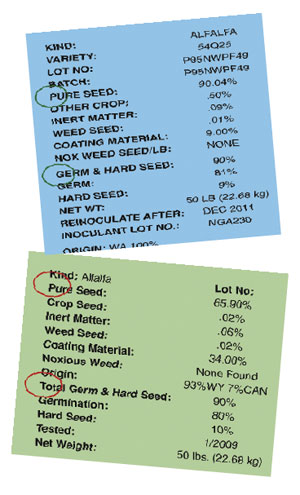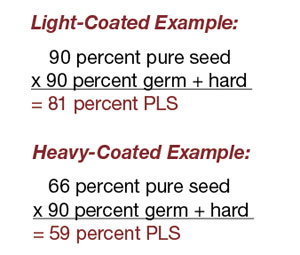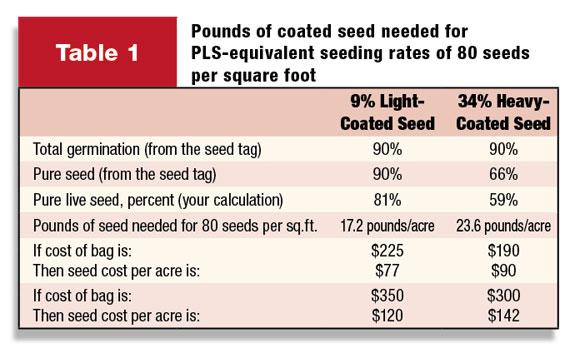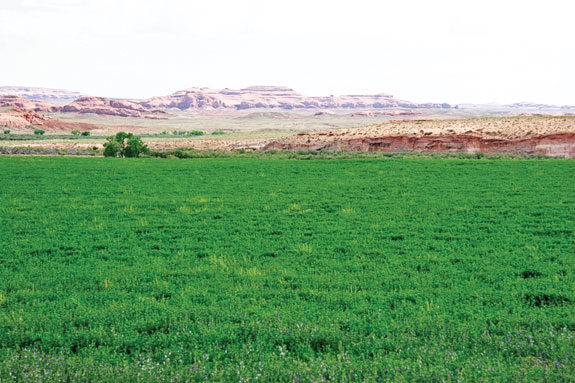Many seed companies sell coated alfalfa seed, and the coating material can range from 9 percent up to 34 percent of total weight or more.
Rhizobium, fungicide and colorant account for approximately 3 percent of the coating weight.
Any additional weight listed as coating material on the seed tag is usually a mineral such as limestone, gypsum or mica, with a polymer that binds these materials to the seed. The most common coating is a 34 percent limestone coat.
A light coat of 9 percent typically is applied in a layering process – a layer of fungicide directly on the seed, followed by a separating layer of mica and polymer, then a layer of rhizobia, with a final layer of mica and polymer.
This results in separation of fungicide from rhizobia and provides for optimal rhizobial activity and longevity. The mica provides good flowability, as opposed to limestone or gypsum, commonly used in heavy-coated seed.

Alfalfa growers should realize these coatings add volume and weight to the bag – volume beyond the actual seed.
This added volume reduces the number of live seeds per pound, increasing the risk of inadequate stand establishment if the seeding rate per acre is not adjusted accordingly.
This is especially true with cloddy seedbeds or increased weed pressure during early growth.
It is important to understand what you’re buying and how that may affect your alfalfa stand.
Adjust seeding rates
Growers should adjust seeding rates based on the level of pure live seed (PLS) per unit of alfalfa seed. You can calculate pure live seed from information on the tag.
Pure live seed is the seed you can expect to germinate and contribute to stand establishment. In the case of the light-coated example above, multiply the 90 percent pure seed times 90 percent germination, to equal 81 percent pure live seed.
The heavy-coated tag at the right shows 66 percent pure seed, with a 90 percent total germ. The calculation for this heavy-coated seed is 66 percent pure seed multiplied by 90 percent total germ, equaling only 59 percent pure live seed.

That’s quite a difference, and one that could affect stand density unless seeding rate is adjusted.
Some confusion exists about whether to count hard seed when calculating pure live seed. State seed-certifying agencies include hard seed as viable seed.
Hard seed is included in the total germ on the tag and needs to be included in the pure live seed calculation. Hard seed is viable seed that does not germinate within the seven-day germination test period.
Many seed companies scarify seed lots to keep hard seed in an acceptable range of 10 percent or less of finished seed.
Scarification is the scratching or cracking of the seed coat to allow moisture to penetrate for germination. Higher percentages of hard seed in some bags may indicate a lack of scarification and may lead to a lengthier stand establishment period.
What the PLS score means
A good stand of alfalfa will have 20 to 25 plants per square foot following its first winter. To achieve this, you must plant enough seed to allow for attrition that occurs as seedlings emerge, contend with diseases and compete with weeds.
Throughout most of North America, alfalfa growers have settled into seeding rates that achieve about 80 pure live seeds per square foot. This equates to 13.9 pounds of pure live seed per acre, assuming 250,000 seeds per raw pound.
This equals 16 pounds per acre of traditional pink-treated seed at 90 percent total germination, which includes about 3 percent weight gain from fungicide, rhizobium and colorant.

Using this as a starting point, Table 1 shows the pounds of pure live seed and equivalent seeding rates needed to achieve 80 pure live seeds per square foot.
Adjust your seeding rate for the amount of PLS as affected by total germination and the amount of seed coating. Table 1 shows pounds of coated seed needed for PLS-equivalent seeding rates of 80 seeds per square foot.
Without this seeding rate adjustment for pure live seed, you’ll be reducing the number of seeds per square foot and increasing the risk of attaining a full stand of alfalfa.
This creates problems in cloddy soil conditions or less-than-ideal seedbeds. Lower seeding rates of PLS are associated with reduced yield in the establishment year.
There is an increased risk of non-uniform or spotty stands with reduced seeding rates and with seed having a higher hard seed percentage. Spotty stands hurt production throughout the stand’s life. Weed competition can be more impactful in non-uniform stands too, further reducing yield and quality.
In the example above, the heavy-coated seed costs more per acre than light-coated seed when you adjust for PLS equivalency.
To find out what’s in your bag of alfalfa seed, ask your seed supplier to provide a specific seed tag of the variety.
Inert matter and/or coating material must appear on all seed tags. The better you understand what you’re planting, the more likely you’ll be able to establish a long-term, viable alfalfa stand. You also might save money by buying the optimal amount of seeds per acre. FG
A good stand of alfalfa will have 20 to 25 plants per square foot following its first winter. To achieve this, you must plant enough seed to allow for attrition that occurs as seedlings emerge, contend with diseases and compete with weeds.Photo by FG staff.












